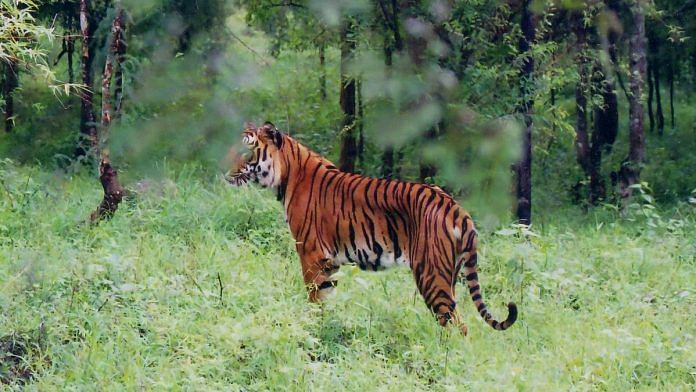New Delhi: The Parliamentary Standing Committee on Environment and Climate Change has suggested a new body to manage the growing human-animal conflict.
Led by Rajya Sabha Member of Parliament Jairam Ramesh — who was minister for environment and forest under the Manmohan Singh government — the Committee submitted Thursday its comments and suggestions on the Wildlife Protection Amendment Bill, 2021, which was introduced in Parliament in December last year. The Committee urged the government to set up state-level Human-Animal Conflict Advisory Committees that can mitigate such conflict, calling it “a complex issue as serious as hunting”.
The Wildlife Protection Amendment Bill was introduced last year to amend the Wildlife Protection Act of 1972 — a law that provides a framework for the protection of wild plants, birds, and animals.
The purpose of the amendments, the government said, was to align it with the Convention on International Trade in Endangered Species of Wild Fauna and Flora (CITES), to which India is a signatory. CITES seeks to regulate the international trade of wild animals and plants and requires member states to enact appropriate legislation.
While a framework to manage international wildlife trade is broadly welcome, “the approach proposed in the Bill will make the principal Act too unwieldy and complicated”, the Committee said in its comments.
The Committee received representations from dozens of organisations and wildlife experts, who expressed concern over the introduction of a Standing Committee for State Wildlife Boards, among other issues.
Also Read: Turning deathtraps into shrines, how Ladakh’s pashmina goatherds learnt to live with wolves
Scraps provision for elephant transport
The State Board for Wildlife (SBWL) is the state-level body in charge of conservation and protection and has the power to advise state governments on selecting protected areas as well as grant clearances for projects. They are often chaired by high-ranking officials, such as the chief minister. The government proposes the introduction of a Standing Committee that can take decisions on behalf of these boards in order to make them “more purposive.”
The House panel, however, has said this proposal “has caused considerable anguish in the wildlife conservation community”, because of the “legitimate worry” that it will “end up being a rubber stamp for faster clearances of projects.”
The proposal follows the national level model, where the Standing Committee of the National Board for Wildlife takes all decisions and grants clearances for projects on behalf of the NBWL, which meets rarely.
If the proposal is to go through, the panel says it must mandatorily include at least three members from institutions such as the Indian Council of Forestry Research and Education, the Director (or nominee) from the Wildlife Institute of India. In addition, one-third of its members should be from outside the SBWL to ensure that the panel isn’t “crowded” by officials.
The Jairam Ramesh-led Committee also recommends scrapping a clause in the Bill that allows for the transfer and transport of live elephants by “certified” private owners. “Nothing should be done to even give an impression that private ownership of elephants and trade in them is going to be encouraged,” the panel says in its comments. However, it does say that a provision should be made for religious institutions to acquire elephants, “to strike a careful balance to ensure that age-old traditions are not interfered with.”
The Wildlife Protection Act in its current form prohibits the transfer or sale of any wild animal.
Also Read: Exemption for ‘strategic’ highways, mining extensions: How govt’s reshaping environmental clearance
Endangered species
Another significant change the Bill proposes is to introduce a new chapter into the Act that deals specifically with the regulation and international trade of endangered species to fulfil the requirements of CITES. The amendment also includes a list of the species to which the chapter is applicable.
The House panel said this could “introduce contradictions” into a law that is prohibitive in nature since “the underlying theme of CITES is facilitative or enabling”.
Instead of a new chapter, the Committee recommended making minor amendments to existing sections and definitions that would fulfill CITES requirements “without disturbing the basic structure of the principal Act”.
The Ministry of Environment, however, rejected this proposal, saying it “will in no significant way improve India’s implementation of CITES. On the other hand, they will result in application of very strict domestic regulations to CITES-listed species which are not required by the Convention”.
Other observations
The Bill also replaces the current six Schedules – based on how much protection each plant or animal receives – with three Schedules.
Under the proposed new regime, Schedule I species will enjoy the highest level of protection, Schedule II species will be subject to a lesser degree of protection and Schedule III covers plants.
“Currently, the Schedules I, II, and III are having most of the bird species, but the same cannot be said for mammals, reptiles, amphibians, fish, invertebrates, and plants,” the panel said in its report.
“The Committee is in agreement with this proposal. However, it finds a number of species missing in all the three Schedules. It also finds species that should be in Schedule I but have been placed in Schedule II,” says the panel report, adding that the government needs to fix this “anomaly”.
(Edited by Uttara Ramaswamy)
Also Read: 10-fold rise in intense forest fires in India from 2000 to 2019, study points to climate change



